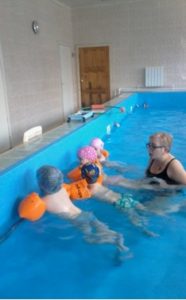Teacher of the speech therapy group
MBDOU Kindergarten Combined Kindergarten No5 "Rodnichok", Lukhovitsy
Initial mathematical knowledge is acquired by the child at an early age. Getting acquainted with mathematics gives the firstintuitiveThe world is not chaos, butrather thinarchitecture, which has the canon of its creation, and mancapableTouch this canon. Mathematics givesopportunity to seeorder and certainty, symmetry and proportionalityhowin nature as well as in true art. “Natureformulatelaws in the language of mathematics.” These words belong to Galileo.
To introduce children to the simplest laws of mathematicsthemelementary mathematical concepts, to make clear,worldlyorderly and therefore comprehensible, and therefore predictable to man — these are the main goals of mathematics.
What should we, teachers of preschool institutions, be guided by, what to know, what to remember, what to follow, forming elementary mathematical concepts for children?
First of all, whatever program we are working on, we must clearly present its content. Any programFAMPIt includes the following sections: “Quantity and count”, “Quantity”. “Form,” “Time Orientation,” “Space Orientation.” The program of the junior group is limited to the pre-numerical period of study and includes sections: "Quantity", "Form", "Quantity".
The initial principles of building all sections of the program are systematic and consistent, which allow to provide a certain level of both the general development of the child, his cognitive interests and creative abilities, and mathematical development, and it in turn involves the assimilation of a number of ideas, concepts, relationships, patterns (number, number, order, equality - inequality, whole - part, magnitude - measure, etc.).
In addition, the program is built taking into account the age characteristics of children and with a gradual complication of educational tasks, most often arising from one another.
Special attention should be paid to the final part – “By the end of the year, children should be able to”, which will allow us to understand what knowledge the child should master by the end of the school year, will also help in the preparation and monitoring of children with elementary mathematical concepts. The importance of the latter lies in the fact that it helps us to see a clear picture of the assimilation of certain knowledge by each child individually and to trace the dynamics of growth.
It is not a fact that having studied the program well and knowing the tasks set before us, we will be able to methodically correctly transfer elementary mathematical knowledge to children. This book will help us “Methodical recommendations for the Program of education and training in kindergarten”, which reveals the features of working with children to implement the educational tasks set in it and which should become our handbook.
Methodological recommendations are prepared taking into account the materials of scientific research carried out at different times under the guidance of Wenger, Zaporozhets, Leushina, Metlina, Taruntayeva, etc.
Modern compilers of “Methodical recommendations”, as well as the above-mentioned authors, advocate that the education of children was visually effective, that is, that children learn knowledge not only on the basis of the perception of the actions of the teacher and his explanations, but also through independent actions with the didactic material. Therefore, they aim at creating favorable conditions for the successful development of elementary mathematical concepts. There are such conditions in our kindergarten. In mathematical corners there is a fairly rich basic set of various manuals. This handout and demonstration material, mathematical tables, didactic games that cause interest of preschoolers to mathematics, developing their abilities, thinking. In our group, there are many games corresponding to different age levels: “Find a Couple”, “Find your house”, “Develop in shape”, “Find the same figures”, “Domino figures”, “Color lotto”, “Find differences”, “Slice pictures”, “Wonderful bag”, “Tangram”, “Magic wands” and many others. There is a mathematical game with tasks for children in all sections of the program. It is advisable to use such didactic games and exercises to consolidate the material studied, both in your free time and in classes.
Classes are the main form of work on the formation of mathematical representations. It is in the classroom that we solve most of the program problems, form in a certain sequence of presentations, develop the necessary skills and skills.
In the "Methodical Guidelines" we will find clear instructions on the duration of classes in each age group. We can use the approximate distribution of program material for the entire academic year, which greatly facilitates the process of thematic planning. There is also a footnote: the sequence of acquaintance with certain topics can be determined by the educator arbitrarily and vary at his discretion.
{module Google_kvadrat}
Next, and importantly, we get information about the structure of the occupation. We understand that the structure occupied is determined by the volume, content, combination of program tasks, the level of assimilation of relevant knowledge, age characteristics of children. The study of new material includes such types of work: showing and explaining, demonstrating a sample, identifying the properties and relationships of mathematical objects. In the first lesson, the study of the new is given most of the time, in the subsequent lesson, the study of the new takes half the time limit, the second half is given to repetition of the past. During the year, it is necessary from time to time to return to the repetition of the material already studied.
One of the main conditions for the success of teaching children elementary mathematical concepts is knowledge of the methodology and knowledge of it.
Mathematics is an exact science, with definite laws and numerous terms. Therefore, it requires us, educators, to use clear, traditionally established methods and techniques, regardless of what program we work on.
Methods of working with children of each age group are widely presented in the "Methodical recommendations". There are many methodological aids, but most often we use the technique of Metlin, which bribes us with its consistency, consistency, clear specificity, variety of techniques and methods in solving each program problem.
Valuable in the method of Metlina and the fact that she has a coherent and consistently built system of questions addressed to children. The questions are concise, mathematically literate and specific.
Consider the method on the example of teaching children the composition of the number of units. In the older group, we introduce children to the composition of the units of the first heel. The composition of the number of units is shown on a specific material. Moreover, at the first stage of acquaintance with the composition of the number of units, as advised by Metlin, we select three-dimensional groups of objects in which each object differs from others (1 nesting doll, 1 pyramid ...). Next, we use objects of the same type, but differing from each other either in color, or in size, or in shape (sets of colorful flags, a set of nesting dolls, Christmas trees of different heights, etc.). Later - objects united by one generic concept (sets of dishes, furniture, vegetables) At the final stage, we use flat images of objects or subject pictures.
To understand the composition of the number of units will help clearly formulated specific questions:
- How many toys are there?
- What can you tell us about the toys?
- How many pyramids? Ball?
- How many of them are each? (How many different toys?)
- How did 5 toys come about?
To communicate knowledge and awareness of the quantitative value of the number, we ask children questions: How many different toys will you take if youя What's the number 4? How many times will you jump if I call the number 1? And we offer to perform these actions and movements.
To consolidate knowledge about the composition of the number, we use word and didactic games. ("Name 4 items", "Who will name 5 headgear faster?", "Put a square of sticks of different colors ...)
The consolidation of the studied material is facilitated by our narrow specialists, who include the methodological content in the context of traditional activities: drawing, application, movement to music.
For individual work, we use situations of dressing, walking, preparing for lunch, preparing for classes, etc. – in short, all kinds of situations of a child’s daily life. Individual workbooks in mathematics also became a great help for us.
We start working with the children of the preparatory group by repeating the educational material studied in the senior group, and then proceed to acquaintance with the composition of the number from the units of the second heel. In addition to the above methods, we use new, complicated ones; sketching a certain number of different objects or geometric figures, distributing objects into groups according to one of the features, distinguishing each group as a unit of account and determining the total number of groups.
Six-year-old children can simultaneously name two numbers and give the task to make two groups of objects at once: on the upper strip to make a group of 3 different geometric shapes, on the lower strip - of 4. At the same time, pay attention not only to the quantitative composition, but also to the relationship between numbers (how much one number is more or less than another).
Gradually, children begin to realize that each number contains a certain number of units and can answer more complex questions: “How many items will you take if I name the number 7?” Why?, How is the number 7?, How many units is there in the number 7?
Such scrupulousness, to some extent even pedantry, as well as an appeal to various, correct methodical techniques, we must use when solving any program problem.
But the accuracy and rigor of mathematics as a science should not result in the dryness of its teaching to children. That is why a playful form of learning is welcomed, which contributes to the development of children's interest in mathematics, a more emotional perception of the stingy mathematical laws and the qualitative assimilation of these laws.



